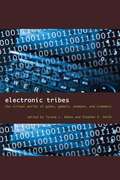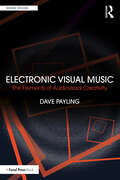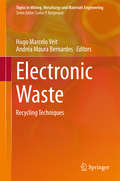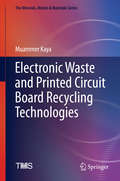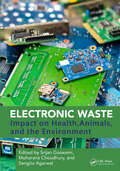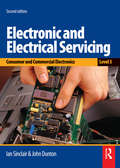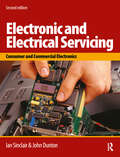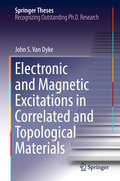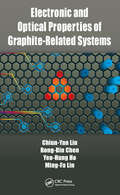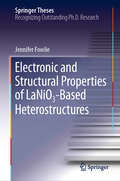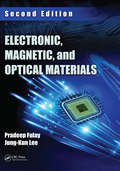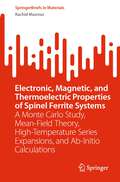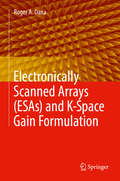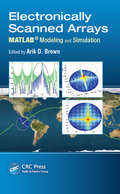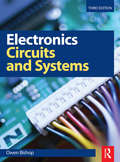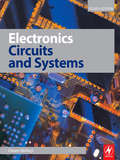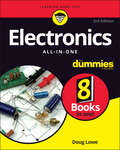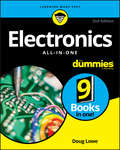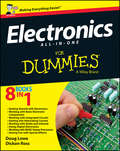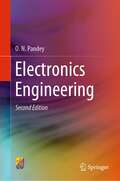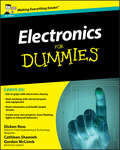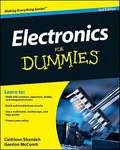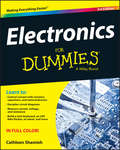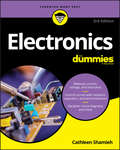- Table View
- List View
Electronic Transport in Mesoscopic Systems
by Supriyo DattaRecent advances in semiconductor technology have made possible the fabrication of structures whose dimensions are much smaller than the mean free path of an electron. This book is the first to give a thorough account of the theory of electronic transport in such mesoscopic systems. After an initial chapter covering fundamental concepts, the transmission function formalism is presented, and used to describe three key topics in mesoscopic physics: the quantum Hall effect; localisation; and double-barrier tunnelling. Other sections include a discussion of optical analogies to mesoscopic phenomena, and the book concludes with a description of the non-equilibrium Green's function formalism and its relation to the transmission formalism. Complete with problems and solutions, the book will be of great interest to graduate students of mesoscopic physics and nanoelectronic device engineering, as well as to established researchers in these fields.
Electronic Tribes
by Stephen A. Smith Tyrone L. AdamsWhether people want to play games and download music, engage in social networking and professional collaboration, or view pornography and incite terror, the Internet provides myriad opportunities for people who share common interests to find each other. The contributors to this book argue that these self-selected online groups are best understood as tribes, with many of the same ramifications, both positive and negative, that tribalism has in the non-cyber world. In Electronic Tribes, the authors of sixteen competitively selected essays provide an up-to-the-minute look at the social uses and occasional abuses of online communication in the new media era. They explore many current Internet subcultures, including MySpace. com, craftster. org, massively multiplayer online role-playing games (MMORPGs) such as World of Warcraft, music downloading, white supremacist and other counterculture groups, and Nigerian e-mail scams. Their research raises compelling questions and some remarkable answers about the real-life social consequences of participating in electronic tribes. Collectively, the contributors to this book capture a profound shift in the way people connect, as communities formed by geographical proximity are giving way to communities - both online and offline - formed around ideas.
Electronic Visual Music: The Elements of Audiovisual Creativity (Sound Design)
by Dave PaylingElectronic Visual Music is a comprehensive guide to the composition and performance of visual music, and an essential text for those wanting to explore the history, current practice, performance strategies, compositional methodologies and practical techniques for conceiving and creating electronic visual music. Beginning with historical perspectives to inspire the reader to work creatively and develop their own individual style, visual music theory is then discussed in an accessible form, providing a series of strategies for implementing ideas. Including interviews with current practitioners, Electronic Visual Music provides insight into contemporary working methods and gives a snapshot of the state of the art in this ever-evolving creative discipline. This book is a valuable resource for artists and practitioners, as well as students, educators and researchers working in disciplines such as music composition, music production, video arts, animation and related media arts, who are interested in informing their own work and learning new strategies and techniques for exploration and creative expression of electronic visual music.
Electronic Waste
by Hugo Marcelo Veit Andréa Moura BernardesThis book presents an overview of the characterization of electronic waste. In addition, processing techniques for the recovery of metals, polymers and ceramics are described. This book serves as a source of information and as an educational technical reference for practicing scientists and engineers, as well as for students.
Electronic Waste and Printed Circuit Board Recycling Technologies (The Minerals, Metals & Materials Series)
by Muammer KayaThis book covers state-of-the-art technologies, principles, methods and industrial applications of electronic waste (e-waste) and waste PCB (WPCB) recycling. It focuses on cutting-edge mechanical separation processes and pyro- and hydro-metallurgical treatment methods. De-soldering, selective dismantling, and dry separation methods (including the use of gravity, magnetic and electrostatic techniques) are discussed in detail, noting the patents related to each. The volume discusses the available industrial equipment and plant flowsheets used for WPCB recycling in detail, while addressing potential future directions of the field. This practical, comprehensive, and multidisciplinary reference will appeal to professionals throughout global industrial, academic and government institutions interested in addressing the growing problem of e-waste. Covers principles, methods and industrial applications of e-waste and PCB recycling;Details state-of-the-art mechanical separation processes and pyro- and hydro-metallurgical treatment methods; Describes the available industrial equipment used and plant flowsheets for PCB recycling and addresses potential future developments of this important field.
Electronic Waste: Impact on Health, Animals, and the Environment
by Srijan Goswami Moharana Choudhury Sangita AgarwalThis book examines the detrimental impact of electronic waste on human health, animal welfare, and environmental ecosystems. The initial chapter discusses and explores the damaging effect of electronic waste on human health, animal welfare, and environmental ecosystems. The initial chapter discusses electronic waste’s sources, composition, and toxicity. The book exposes the far-reaching consequences of electronic waste on our planet, from the contamination of air, water, and soil to the alarming threats to wildlife, insects, and microorganisms. It also underscores the risks of e-waste to food safety, animal farming practices, public health, and the nervous system.Furthermore, the book delves into innovative recycling technologies, systematic management strategies, and the economic impacts associated with e-waste management, emphasizing the necessity of sustainable value chains and adopting a circular economy approach. It offers insights into the financial dimensions of e-waste management and the potential for creating sustainable value chains.It provides a comprehensive perspective on this global challenge and offers sustainable solutions for the future. This book is a valuable resource for researchers, policymakers, and environmentalists working to understand the harmful impact of electronic waste on health, the environment, and sustainability. The sources are composition, and toxicity of electronic waste.Key features Examines the threats posed by electronic waste (e-waste) to human, animal, and environmental health Presents sources, types, composition, and toxicity of electronic waste Places a strong emphasis on the impact of e-waste on wildlife and biodiversity, highlighting threats to ecosystems Reviews impact of electronic waste on animal farming practices and the associated health concerns Discusses innovative recycling technologies and systematic management strategies for e-waste Explores the potential for a circular economy approach in e-waste management, emphasizing sustainability
Electronic and Electrical Servicing - Level 3
by John DuntonElectronic and Electrical Servicing – Level 3 follows on from the Level 2 book and covers the more advanced electronics and electrical principles required by service engineers servicing home entertainment equipment such as TVs, CD and DVD machines, as well as commercial equipment including PCs.All the core units of the Level 3 Progression Award in Electrical and Electronics Servicing (Consumer/Commercial Electronics) from City & Guilds (C&G 6958) are covered. The book also offers a fully up-to-date course text for the City & Guilds 1687 NVQ at Level 3.The book contains numerous worked examples to help students grasp the principles. Each chapter ends with review questions, for which answers are provided at the end of the book, so that students can check their learning.Units covered:Unit 1 – Electronic principlesUnit 2 – Test and measurementUnit 3 – Analogue electronicsUnit 4 – Digital electronicsIan Sinclair has been an author of market-leading books for electronic servicing courses for over 20 years, helping many thousands of students through their college course and NVQs into successful careers. Now with a new co-author, John Dunton, the new edition has been brought fully up-to-date to reflect the most recent technical advances and developments within the service engineering industry, in particular with regard to television and PC servicing and technology.Level 2 book:Electronic and Electrical Servicing, ISBN 978-0-7506-6988-7, covers the 5 core units at Level 2, plus the option units Radio and television systems technology (Unit 6) and PC technology (Unit 8).
Electronic and Electrical Servicing: Level 2
by John DuntonElectronic and Electrical Servicing provides a thorough grounding in the electronics and electrical principles required by service engineers servicing home entertainment equipment such as TVs, CD and DVD machines, as well as commercial equipment including PCs.In the printed book, this new edition covers all the core units of the Level 2 Progression Award in Electrical and Electronics Servicing (Consumer/Commercial Electronics) from City & Guilds (C&G 6958), plus two of the option units. For those students who wish to progress to Level 3, a further set of chapters covering all the core units at this level is available as a free download from the book’s companion website or as a print-on-demand book. The book and website material also offer a fully up-to-date course text for the City & Guilds 1687 NVQs at Levels 2 and 3.The book contains numerous worked examples to help students grasp the principles. Each chapter ends with review questions, for which answers are provided at the end of the book, so that students can check their learning.Level 2 units covered in the book:Unit 1 – d.c. technology, components and circuitsUnit 2 – a.c. technology and electronic componentsUnit 3 – Electronic devices and testingUnit 4 – Electronic systemsUnit 5 – Digital electronicsUnit 6 – Radio and television systems technologyUnit 8 – PC technologyIan Sinclair has been an author of market-leading books for electronic servicing courses for over 20 years, helping many thousands of students through their college course and NVQs into successful careers. Now with a new co-author, John Dunton, the new edition has been brought fully up-to-date to reflect the most recent technical advances and developments within the service engineering industry, in particular with regard to television and PC servicing and technology.Level 3 units covered in free downloads at http://books.elsevier.com/companions/9780750669887:Unit 1 - Electronic principlesUnit 2 - Test and measurementUnit 3 - Analogue electronicsUnit 4 - Digital electronics
Electronic and Magnetic Excitations in Correlated and Topological Materials (Springer Theses)
by John S. Van DykeThis thesis reports a major breakthrough in discovering the superconducting mechanism in CeCoIn5, the “hydrogen atom” among heavy fermion compounds. By developing a novel theoretical formalism, the study described herein succeeded in extracting the crucial missing element of superconducting pairing interaction from scanning tunneling spectroscopy experiments. This breakthrough provides a theoretical explanation for a series of puzzling experimental observations, demonstrating that strong magnetic interactions provide the quantum glue for unconventional superconductivity. Additional insight into the complex properties of strongly correlated and topological materials was provided by investigating their non-equilibrium charge and spin transport properties. The findings demonstrate that the interplay of magnetism and disorder with strong correlations or topology leads to complex and novel behavior that can be exploited to create the next generation of spin electronics and quantum computing devices.
Electronic and Optical Properties of Graphite-Related Systems
by Ming-Fa Lin Chiun-Yan Lin Rong-Bin Chen Yen-Hung HoThis book provides an overview of electronic and optical properties of graphite-related systems. It presents a well-developed and up-to-date theoretical model and addresses important advances in essential properties and diverse quantization phenomena. Key features include various Hamiltonian models, dimension-enriched carbon-related systems, complete and unusual results, detailed comparisons with the experimental measurements, clear physical pictures, and further generalizations to other emergent 2D materials. It also covers potential applications, such as touch-screen panel devices, FETs, supercapacitors, sensors, LEDs, solar cells, photodetectors, and photomodulators.
Electronic and Structural Properties of LaNiO₃-Based Heterostructures (Springer Theses)
by Jennifer FowlieThis thesis explores an amazing family of oxide compounds - the nickelates - known for their metal-to-insulator transition and, in the case of LaNiO3, to be a possible building block for designing a synthetic high Tc superconductor. Competition between various fascinating phases makes these materials very sensitive to external parameters and it is thus possible to dramatically tune their properties. This work on ultrathin LaNiO3 and the solid solution Nd1-xLaxNiO3 has important implications for the search for superconductivity in this class of materials.
Electronic, Magnetic, and Optical Materials
by Pradeep Fulay Jung-Kun LeeThis book integrates materials science with other engineering subjects such as physics, chemistry and electrical engineering. The authors discuss devices and technologies used by the electronics, magnetics and photonics industries and offer a perspective on the manufacturing technologies used in device fabrication. The new addition includes chapters on optical properties and devices and addresses nanoscale phenomena and nanoscience, a subject that has made significant progress in the past decade regarding the fabrication of various materials and devices with nanometer-scale features.
Electronic, Magnetic, and Thermoelectric Properties of Spinel Ferrite Systems: A Monte Carlo Study, Mean-Field Theory, High-Temperature Series Expansions, and Ab-Initio Calculations (SpringerBriefs in Materials)
by Rachid MasrourThis book explores magnetic properties and critical temperatures in inverse ferrite Fe₃⁺(M₂⁺Fe₃⁺)O₄ spinels (e.g., Fe, Co, Ni). It calculates transition and Curie Weiss temperatures, providing insights into their thermodynamic behavior. Using the full potential linearized augmented plane wave (FP-LAPW) method, it investigates electrical and magnetic structures of spinel chromite, revealing magnetic moments in MnCr₂S₄. Seebeck coefficient and electrical conductivity are also calculated. Advanced techniques like Monte Carlo, DFT+U, and FLAPW analyze magnetic characteristics of LiMn₁.₅Ni₀.₅O₄ and electronic/magnetic structures of Fe₃O₄. High-temperature series expansions calculate Néel temperature and critical exponents, while GFT determines thermal magnetization and susceptibility. The analysis exposes exchange interactions' effects on magnetic order and introduces asymmetric phases in ferrimagnetic spinel systems. This book serves as an invaluable resource for researchers, academics, and enthusiasts seeking a comprehensive understanding of magnetic properties and critical phenomena within diverse spinel materials.
Electronically Scanned Arrays (ESAs) and K-Space Gain Formulation
by Roger A. DanaThis book fills in details that are often left out of modern books on the theory of antennas. The starting point is a discussion of some general principles that apply to all electronic systems and to antennas in particular. Just as time domain functions can be expanded in terms of sine waves using Fourier transforms, spatial domain functions can be expanded in terms of plane waves also using Fourier transforms, and K-space gain is the spatial Fourier transform of the aperture weighting function. Other topics discussed include the Discrete Fourier Transform (DFT) formulation of antenna gain and what is missing in this formulation, the effect of sky temperature on the often specified G/T ratio of antennas, sidelobe control using conventional and novel techniques, and ESA digital beamforming versus adaptive processing to limit interference. Presents content the author derived when first asked to evaluate the performance of an electronically scanned array under design with manufacturing imperfections and design limitations;Enables readers to understand the firm theoretical foundation of antenna gain even when they must start from well-known formulations rather than first principles;Explains in a straightforward manner the relationship between antenna gain and aperture area;Discusses the relationship between sidelobe control algorithms and aperture shape, how to take advantage of it, and what the penalties are;Shows the equivalence of Minimum-Variance, Distortionless Response (MVDR) and Space-Time Adaptive Processing (STAP) and how these algorithms can be used with ESA subarrays to mitigate interference.
Electronically Scanned Arrays MATLAB® Modeling and Simulation: Fundamentals And Applications (Ieee Press Ser.)
by Arik D. Brown"[Contains] more lengthy mathematical derivations than most {comparable books] … for arrays, provides for a unique, stand-alone mathematical description that can be adopted by anyone trying to communicate the theoretical foundation for their array design…has insights from a practitioner that are unique. The MATLAB® scripts alone are worth the price." —Daniel C. Ross, Ph. D, Northrop Grumman Corporation Electronically Scanned Arrays: MATLAB® Modeling and Simulation is considered the first book to provide comprehensive modeling/simulation programs used to design and analyze Electronically Scanned Arrays (ESA), a key technology internationally in the scientific and engineering communities. Several books have been written about ESAs, but most cover only fundamental theory. Few, if any, provide the insightful, easy-to-use simulation tools found in this book. Obviously, MATLAB® is one of the greatest tools available for exploring and understanding science and engineering concepts, and we use MATLAB functions to easily and instantly calculate ESA patterns. However, to achieve a truly insightful and in-depth analysis of subarray architectures, conformal arrays, etc., it is imperative that users first develop a firm grasp of ESA fundamentals. Covers largely unexplored topics, such as reliability aspects and the application of ESAs in space This volume helps readers build that elemental understanding of how ESAs work. It also provides code to run as an aid, so that readers don’t have to start from scratch. The book expands on ESA principles and provides a modeling framework, using MATLAB to model applications of ESAs (i.e. pattern optimization, space-based applications, and reliability analysis). Presented code serves as an excellent vehicle to help readers master the analysis and simulation of ESAs. Exploring how difficult problems can be simplified with short, elegant solutions, this is an invaluable resource for students and others new to ESAs, as well as experienced practicing engineers who model ESAs at the systems level.
Electronics - Circuits and Systems
by Owen BishopThe material in Electronics - Circuits and Systems is a truly up-to-date textbook, with coverage carefully matched to the electronics units of the 2007 BTEC National Engineering and the latest AS and A Level specifications in Electronics from AQA, OCR and WJEC. The material has been organized with a logical learning progression, making it ideal for a wide range of pre-degree courses in electronics. The approach is student-centred and includes: numerous examples and activities; web research topics; Self Test features, highlighted key facts, formulae and definitions. Each chapter ends with a set of problems, including exam-style questions and multiple-choice questions.The book is now also supported by a companion website featuring extensive support for students and lecturers, including answers to the questions in the book, interactive exercises, extra math support and selected illustrations from the book.
Electronics - Circuits and Systems
by Owen BishopFirst Published in 2010. Routledge is an imprint of Taylor & Francis, an informa company.
Electronics All-in-One For Dummies
by Doug LoweOpen up a world of electronic possibilities with the easiest "how-to" guide available today If you're looking for a new hobby that's tons of fun—and practical to boot—electronics might be right up your alley. And getting started has never been easier! In Electronics All-in-One For Dummies, you'll find a plethora of helpful information, from tinkering with basic electronic components to more advanced subjects like working with digital electronics and Arduino microprocessors. Whether you're just getting started and trying to learn the difference between a circuit board and a breadboard, or you've got a handle on the fundamentals and are looking to get to the next level of electronics mastery, this book has the tools, techniques, and step-by-step guides you need to achieve your goals—and have a blast doing it! You'll learn: Critical safety tips and strategies to keep yourself and your environment protected while you work Useful schematics for everyday devices you can put to work immediately, like animated holiday lights and animatronic prop controllers How to work with alternating current, direct current, analog, digital, and car electronics, as well as Raspberry Pi technologies Perfect for anyone who's ever looked at a circuit board and thought to themselves, "I wonder how that works?", Electronics All-in-One For Dummies is your go-to guide to getting a grip on some of the coolest electronic technologies on the market.
Electronics All-in-One For Dummies (For Dummies Series)
by Doug LoweTake your electronics skills to the next level! If you're looking for a solitary resource that covers everything you need to know about electronics, then look no further. This friendly-and-straightforward guide introduces the basics of electronics and enhances your learning experience by debunking and explaining concepts such as circuits, analog and digital, schematics, voltage, safety concerns, and more. Packed with nearly 900 pages of detailed information, this book shows you how to develop your own breadboard, design your own circuit, and get savvy with schematics. Covers the basics of electronics and demystifies a variety of electronics concepts Encourages you to dive in and design a variety of fun and interesting entertainment, electronics, mobile, and automotive projects Offers troubleshooting advice for common electronics challenges Reviews circuits, schematics, voltage, safety concerns, and much more So, get plugged in and start your next electronics project today with this book by your side!
Electronics All-in-One For Dummies - UK
by Doug Lowe Dickon RossYour one-stop UK shop for clear, concise explanations to all the important concepts in electronics and tons of direction for building simple, fun electronic projects. The 8 mini-books in this 1 volume include: Getting Started with Electronics Working with Basic Components Working with Integrated Circuits Getting into Alternating Current Working with Radio and Infrared Doing Digital Electronics Working with Basic Stamp Processors Building Special Effects With nearly 900 pages of instruction, Electronics All-in-One For Dummies, UK Edition covers all the bases and provides a fascinating hands-on exploration of electronics.
Electronics Engineering
by O. N. PandeyThis book is primarily designed to serve as a textbook for undergraduate students of electrical, electronics, and computer engineering, but can also be used for primer courses across other disciplines of engineering and related sciences. The first edition of this book was published in 2015. The book has been completely revised and a chapter on PSPICE has also been included. The book covers all the fundamentals aspects of electronics engineering, from electronic materials to devices, and then to basic electronic circuits. The topics covered are the basics of electronics, semiconductor diodes, bipolar junction transistors, field-effect transistors, operational amplifiers, switching theory and logic design, electronic instruments, and Pspice. The book is written in a simple narrative style that makes it easy to understand for the first year students. It includes a lot of illustrative diagrams and examples, to enable students to practice. Each chapter contains a summary followed by questions asked during the University examinations to enable students to practice before the final examination. The contents of this book will be useful also for students and enthusiasts interested in learning about basic electronics without the benefit of formal coursework.
Electronics For Dummies
by Cathleen Shamieh Dickon Ross Gordon MccombDo you dream of wiring up a flashing LED, experimenting with infrared detectors, or building a walking-talking robot from scratch? Do you want to understand what capacitors, oscilloscopes and transistors actually do? Then look no further!Electronics For Dummies, UK Editioncovers everything from understanding the technology behind day-to-day gadgets, to reading a schematic, getting to grips with multimeters, and devising projects that are both useful and fun. With UK-specific information on where to purchase components for your workbench and the most useful websites and resources, this essential guide will get you up, running, and switched on in no time. Electronics For Dummies, UK Edition includes:Part I: Understanding The Fundamentals of ElectronicsChapter 1: What is Electronics and What Can It Do For You?Chapter 2: Moving Electrons to Make Something HappenChapter 3: Meeting Up with ResistanceChapter 4: Getting a Charge Out of CapacitorsChapter 5: Curling Up With Coils and CrystalsChapter 6: The Wide World of SemiconductorsChapter 7: Packing Parts Together on Integrated CircuitsChapter 8: Rounding Out Your Parts ListPart II: Getting Your Hands DirtyChapter 9: Setting Up Shop and Ensuring Your SafetyChapter 10: Reading SchematicsChapter 11: Constructing CircuitsChapter 12: Measuring and Analysing CircuitsPart III: Putting Theory Into PracticeChapter 13: Exploring Some Learning CircuitsChapter 14: Great Projects You Can Build in 30 Minutes or LessChapter 15: Cool Robot Projects to Amaze Your Friends and FamilyPart IV: The Part of TensChapter 16: Ten (Or So) Terrific Tips to Help You SucceedChapter 17: Ten Great Electronics Parts SourcesChapter 18: Ten Electronics Formulas You Should KnowAppendix: Internet ResourcesGetting Up to Speed with Tutorials and General InformationFiguring Things Out with CalculatorsSurfing for CircuitsAsking Questions in Discussion ForumsGetting Things Surplus
Electronics For Dummies
by Cathleen Shamieh Gordon MccombElectronics is fascinating - want to make something of it? This book shows you how! You can make all sorts of things, once you understand what electronics is and how it works. This book helps you out with that part, explaining the whole thing in plain English. Learn how electricity functions, how to harness it and put it to work, what tools you need to build circuits, what you can make with them, and how to do it safely. Mystery solved - understand what makes your iPod, remote control, and computer work Essential stuff - outfit your electronics lab with all the necessary tools, including some that will surprise you Schematic road maps - learn to read schematics and understand how they help your project get where it's going Symbols of power - recognize all the identifiers for power sources, grounds, and components Tools of the trade - discover how to use a multimeter, logic probe, oscilloscope, and solderless breadboard Break it down - get to know the ins and outs of components such as resistors, capacitors ,diodes and transistors Getting it together - find out how integrated circuits make all the rest possible and learn to work with them & Analyze it - understand the rules that govern current and voltage and learn how to apply them Open the book and find: The difference between electronics and electricity A list of essential tools Cool projects you can build quickly Great places to find parts Important safety tips What a sine wave is Interesting stuff about speakers, buzzers, and DC motors Ohm's Law and how to use it
Electronics For Dummies
by Cathleen ShamiehExplore the basic concepts of electronics, build your electronics workbench, and begin creating fun electronics projects right away! Electronics For Dummies, 3rd Edition is Packed with hundreds of colorful diagrams and photographs, this book provides step-by-step instructions for experiments that show you how electronic components work, advice on choosing and using essential tools, and exciting projects you can build in 30 minutes or less. You'll get charged up as you transform theory into action in chapter after chapter! * Circuit basics -- learn what voltage is, where current flows (and doesn't flow), and how power is used in a circuit* Critical components -- discover how resistors, capacitors, inductors, diodes, and transistors control and shape electric current* Versatile chips -- find out how to use analog and digital integrated circuits to build complex projects with just a few parts* Analyze circuits -- understand the rules that govern current and voltage and learn how to apply them* Safety tips -- get a thorough grounding in how to protect yourself--and your electronics--from harm Electronics For Dummies, 3rd Edition helps you explore the basic concepts of electronics with confidence -- this book will get you charged up!
Electronics For Dummies (For Kids For Dummies Ser.)
by Cathleen ShamiehBuild your electronics workbench—and begin creating fun electronics projects right away Packed with hundreds of colorful diagrams and photographs, this book provides step-by-step instructions for experiments that show you how electronic components work, advice on choosing and using essential tools, and exciting projects you can build in 30 minutes or less. You'll get charged up as you transform theory into action in chapter after chapter! Circuit basics — learn what voltage is, where current flows (and doesn't flow), and how power is used in a circuit Critical components — discover how resistors, capacitors, inductors, diodes, and transistors control and shape electric current Versatile chips — find out how to use analog and digital integrated circuits to build complex projects with just a few parts Analyze circuits — understand the rules that govern current and voltage and learn how to apply them Safety tips — get a thorough grounding in how to protect yourself—and your electronics—from harm Electronics For Dummies (9781119675594) was previously published as Electronics For Dummies (9781119117971). While this version features a new Dummies cover and design, the content is the same as the prior release and should not be considered a new or updated product.

